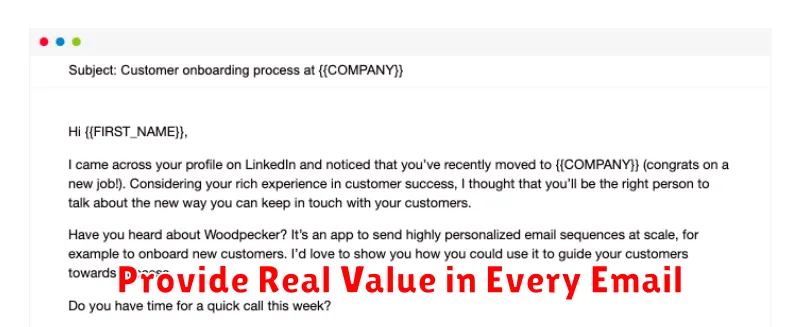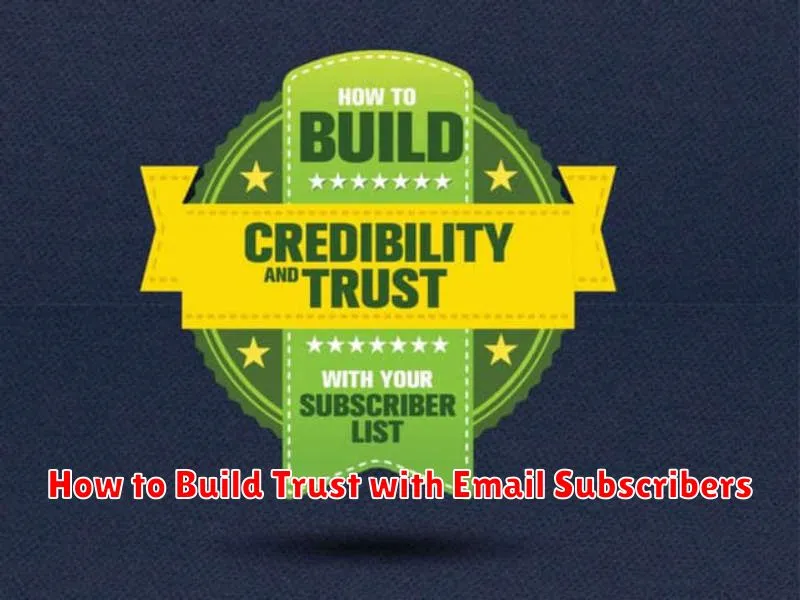In today’s digital landscape, email marketing remains a powerful tool for businesses to connect with their audience. Building trust with your email subscribers is essential for fostering lasting relationships and achieving marketing success. This involves more than just sending promotional emails; it requires a strategic approach centered around providing value, respecting subscriber preferences, and maintaining consistent, transparent communication. Cultivating trust within your email list can lead to higher engagement rates, improved conversion rates, and ultimately, a stronger brand reputation.
This article will delve into the essential strategies for building and maintaining trust with your email subscribers. From crafting compelling, relevant content to respecting data privacy and managing subscriber expectations, we will cover the key components of a successful, trustworthy email marketing strategy. Whether you’re just starting out with email marketing or looking to refine your existing approach, these insights will help you cultivate a loyal and engaged subscriber base, driving meaningful results for your business.
Set Expectations from the Start
Building trust begins with transparency. Clearly communicate what subscribers can expect from your emails. Frequency is a key factor. Tell them how often they’ll receive emails, whether it’s daily, weekly, or monthly. This prevents inbox fatigue and manages expectations.
Content is equally important. Be upfront about the type of content they’ll receive. Will it be promotional offers, newsletters, company updates, or a mix? Setting clear expectations here prevents subscribers from feeling misled or bombarded with irrelevant information.
Consider using a preference center during signup. This allows subscribers to choose the types of content they’re interested in, further solidifying their trust in your brand and increasing engagement.
Use a Consistent Tone and Schedule
Maintaining a consistent tone and sending schedule is crucial for building trust with your email subscribers. This predictability helps subscribers know what to expect from you and reinforces your brand identity.
Tone: Stick to the tone you established when subscribers first signed up. If your initial communication was friendly and informal, don’t suddenly shift to a highly formal tone. Such shifts can feel jarring and damage the relationship you’ve built.
Schedule: Be upfront about how frequently subscribers can expect to hear from you. Whether it’s weekly, bi-weekly, or monthly, stick to the promised schedule as much as possible. Consistency reinforces reliability, a key component of trust. If you’re going to deviate, let subscribers know in advance.
By being consistent in both tone and schedule, you demonstrate respect for your subscribers’ time and inbox, fostering a sense of reliability and professionalism that contributes significantly to building a lasting, trusting relationship.
Provide Real Value in Every Email

Subscribers are constantly evaluating the worth of every email they receive. A cluttered inbox is a universal experience, and your emails must justify their presence. Every email should deliver something of tangible value to the recipient. This encourages them to open future emails and builds a positive association with your brand.
Consider what your audience wants. Is it informative content? Exclusive deals? Early access to products or services? Tailor your email content to consistently provide these elements. Avoid fluff and filler. Prioritize quality over quantity, focusing on delivering concise, impactful information.
Examples of valuable content include:
- Personalized recommendations
- Actionable advice and tips
- Exclusive discounts and promotions
- Early access to new content or products
- Curated industry news and insights
By consistently delivering value, you establish your emails as a worthwhile resource, fostering trust and encouraging continued engagement.
Personalize Content Based on Behavior
Behavioral targeting allows you to tailor email content to subscribers based on their actions. This provides a more relevant and engaging experience, fostering trust.
Track key metrics such as website activity, email opens and clicks, purchase history, and content downloads. Use this data to segment your audience and deliver personalized recommendations, targeted promotions, or specific content related to their demonstrated interests.
For example, if a subscriber frequently browses a particular product category on your website, send them emails featuring similar items or exclusive offers within that category. This demonstrates you understand their needs and strengthens their connection with your brand.
Avoid Over-Promoting
One of the quickest ways to erode trust with your email subscribers is by overwhelming them with promotional content. While the ultimate goal might be sales, constantly pushing products or services can make subscribers feel like they’re just another number on a list, rather than valued members of a community.
Focus on providing value. Share insightful content, helpful tips, exclusive information, or entertaining stories that genuinely benefit your subscribers. This builds a positive relationship and positions you as a trusted source, making them more receptive to promotional messages when they do arrive.
Strike a balance between promotional and non-promotional content. A good rule of thumb is the 80/20 rule: 80% valuable content and 20% promotional. Experiment to find the right ratio for your audience. Monitor unsubscribe rates and engagement metrics to gauge subscriber sentiment and adjust your strategy accordingly.
Show Social Proof and Testimonials
Social proof is a powerful tool for building trust. Showing potential subscribers that others have benefited from your emails can significantly influence their decision to subscribe. Incorporating testimonials and social proof into your email marketing strategy can validate your claims and encourage sign-ups.
Testimonials can be showcased directly on your signup forms or landing pages. A short, impactful quote from a satisfied subscriber can resonate with potential customers. Highlight the positive outcomes they experienced, such as improved skills, access to exclusive content, or valuable insights.
Displaying subscriber counts can also subtly demonstrate value. A high number of subscribers suggests your content is worthwhile and popular. Consider including a phrase like “Join [number] other subscribers” near your signup form.
Social media engagement is another avenue for showcasing social proof. Featuring positive comments or mentions from social media can bolster your credibility. If you have significant positive feedback on platforms like Twitter or Facebook, consider highlighting excerpts on your signup page.
Include Clear Unsubscribe Options
Respecting a subscriber’s wish to opt out is crucial for building trust. A clear and easy-to-find unsubscribe option demonstrates respect for their preferences and prevents frustration. Burying the unsubscribe link or making the process complicated erodes trust and can lead to spam complaints.
Ideally, the unsubscribe link should be placed in the footer of every email. It should be clearly labeled, using text like “Unsubscribe” or “Manage Preferences.” Avoid using small font sizes or light colors that make it difficult to see.
Offering different subscription options, such as reducing email frequency or selecting specific content categories, can also help retain subscribers who might otherwise unsubscribe completely.

